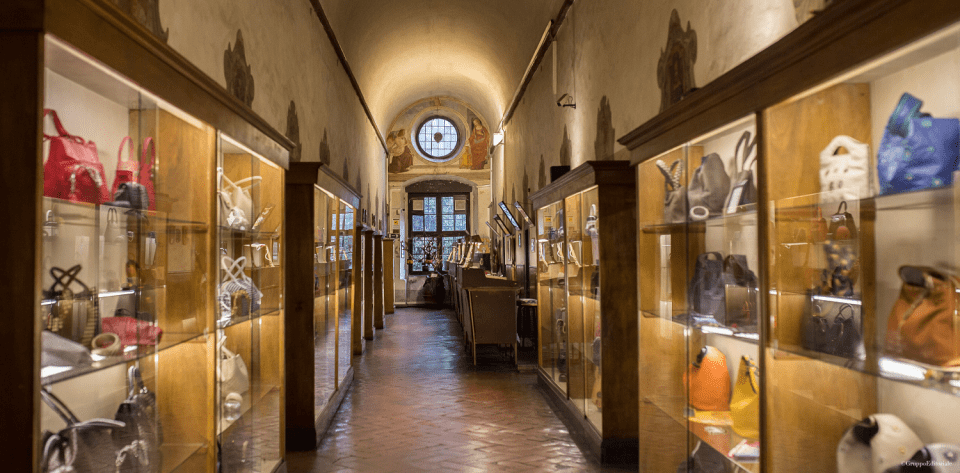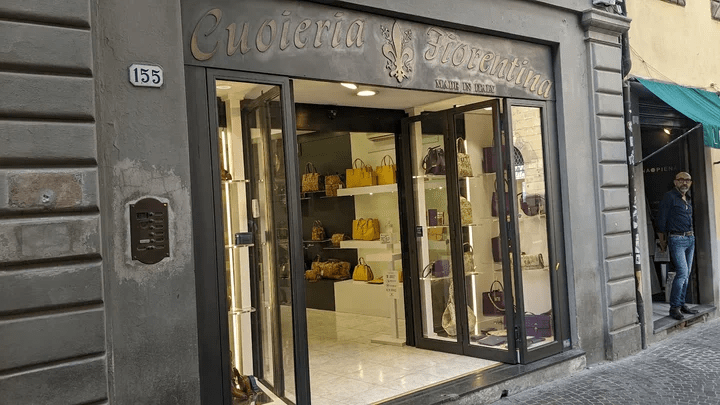Florence is leather. Not the plastic-tasting souvenir-leather you find at the stalls around the Duomo, but honest, vegetable-tanned hides, needle-tight stitching, gloves that fit like second skin and bags that age into heirlooms.
If you want the real thing — pieces made by artisans who live and breathe leather — skip the flashy tourist market and go to the workshops, schools and small ateliers where Florentine craft still has teeth. Below are three trusted places we recommend when you want authenticity over souvenirs: Scuola del Cuoio (the Florence School of Leather), Bottega Fiorentina, and Cuoieria Fiorentina — plus practical buying tips for a low-tourist, high-quality shopping day.
Scuola del Cuoio — learn where the craft comes from

If you want context with your purchase, start at the Scuola del Cuoio (School of Leather). Housed in the cloistered spaces beside Santa Croce, this is more than a shop: it’s a working school and workshop where students and master artisans restore, gild and craft leather in the centuries-old Florentine tradition. The school was founded after World War II as a social and vocational project and remains a place where old techniques are taught and preserved, so buying here feels like an investment in living craft as much as in a product. You can watch artisans at work, ask about techniques (gilding, vegetable tanning, edge finishing), and order custom pieces if you want something bespoke. The school’s shop and workshop are reachable from the Santa Croce courtyard — a distinctly Florentine setting for a shopping experience.
Why go: you’re buying knowledge as well as a bag — the staff will explain provenance, tanning and finishing, and you’ll often get pieces that are lab-finished right behind the displays. Scuola del Cuoio also runs short courses and visits if you want to take a deeper look before you buy.
Address: Via di S. Giuseppe, 5/R, 50122 Firenze FI, Italy
Bottega Fiorentina — an atelier with range and pedigree
Bottega Fiorentina is a family-run atelier that sits on a quieter lane near the historic centre, offering a breadth of small goods and tailored leather clothing alongside bags and belts. The shop prides itself on handmade production in Florence — you’ll find finely finished wallets, driving gloves, and supple backpacks that are far removed from the stamped, mass-market items often pushed toward visitors. The welcome here tends to be warm and personal; staff will discuss leathers, linings and care, and many pieces can be ordered in different leathers or with discreet custom options. If you want something polished and pure Florentine without the tourist-trap theatrics, this is one to stop by.
Why go: excellent for gifts that read as elevated but authentically local — gloves, belts and small leather accessories that feel handmade and will last.
Address: Borgo dei Greci, 5, 50122 Firenze FI, Italy
Cuoieria Fiorentina — the workshop-first brand

Cuoieria Fiorentina began as a workshop and still operates like one: the company sources and works leathers in Tuscany and sells through a small network of outlets plus their production site outside Florence. Their pieces strike a balance between classic Florentine silhouettes and practical, everyday design — think roomy shoulder bags, structured tote classics, and clean wallets made with first-grade hides. If you have the time, check their Reggello location (their production HQ) or their smaller Florence presences to see more of the production side and avoid the purely tourist routes.
Why go: for reliably good materials and sensible, wearable design; Cuoieria tends toward unfussy pieces that get better with age rather than seasonal logo items.
Address: Via dei Ciliegi 25, Reggello, 50066, Italy
Practical tips for buying leather in Florence (so you don’t get burned)
- Ask about tanning and origin. Vegetable-tanned leather is the hallmark of traditional Florentine goods — it will feel firmer at first and develop a patina over time. Ask where hides were sourced and how they were tanned. (Artisans and reputable workshops will be happy to explain.)
- Inspect edges and stitch work. Look for even, tight stitching and finished edges. Raw or uneven edges, loose stitches, or gluey seams are red flags.
- Smell and feel the leather. Real leather smells like leather (not like chemicals). It should feel substantial but supple — not plasticky.
- Ask to see unfinished or in-progress pieces. Real workshops will show you in-process items or scraps; this is useful both for assessment and for a small behind-the-scenes thrill. Scuola del Cuoio and many ateliers will let you peer into their production rooms.
- Prefer workshops and small boutiques over main squares. The big stalls and shops around major monuments will often carry tourist-oriented stock. Walk a few side streets (or head toward the Oltrarno and Santa Croce areas) where independent ateliers cluster.
- Consider custom or made-to-order. Small makers will often offer personalisation and custom sizing — perfect for gloves or a shoulder strap length that’s exactly right.
Where to wander after your leather haul
Pair your shopping with low-key Florentine neighbourhoods: Santa Croce and the surrounding streets house many genuine workshops; the Oltrarno (across the Arno) is famed for artisans in wood, metal and leather and feels less tourist-churned after 5 p.m.; and wandering toward the artisan lanes off Via de’ Tornabuoni will reward you with hidden ateliers and calmer shops.
Final note — a collector’s mindset
Buying in Florence as an experienced shopper means treating each piece as a small archive of technique: who made it, how it was tanned, what repairs might look like in 10 years. The places above — Scuola del Cuoio for the school-workshop experience, Bottega Fiorentina for an atelier approach, and Cuoieria Fiorentina for workshop-led production — will give you access to that lineage and to leather goods that age with dignity, not fast-fashion flash. If you take one piece home that you plan to use for a decade, you’ll understand why Florentine leather still matters.
Tip: Italian Phrase for Custom Orders
When inquiring about custom leather goods, you might say:
“Vorrei sapere se è possibile realizzare un prodotto su misura in pelle. Potrei avere maggiori informazioni?”
This translates to: “I would like to know if it’s possible to make a custom leather product. Could I have more information?”
Feel free to use this phrase when speaking with artisans at any of the above establishments. They will appreciate your interest in their craft and may offer personalised options.
Related Posts:
Exploring Italy’s Boutique Perfumers: A Journey Through Craft, Heritage, and Artisanal Scent



2 Comments